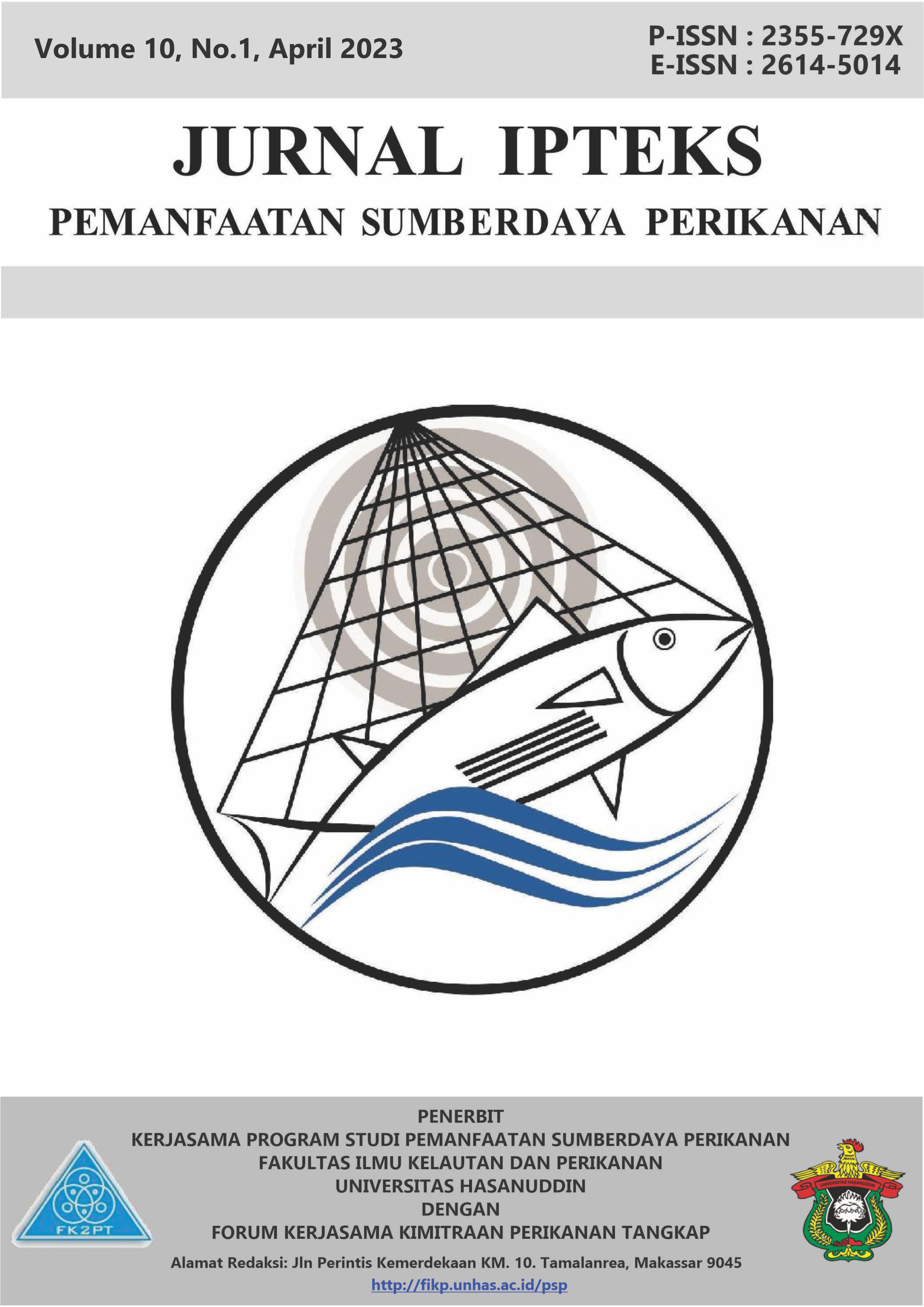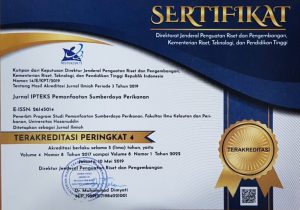Spatial and Temporal Distribution of Skipjack and Little Tuna in Fisheries Management Area 713
Keywords:
IFMA 713, Little tuna, Oceanographic factors, Skipjack tunaAbstract
Indonesian Fisheries Management Area (IFMA) 713 is a strategic and potential area for utilizing large pelagic fishery resources. In general, there are no fixed fishing grounds for large pelagic fish, and they are always changing and moving following the movement of environmental conditions, which naturally causes fish to choose a more suitable habitat. This study examines the distribution and abundance of skipjack tuna (Katsuwonus pelamis) and little tuna (Euthynnus sp) in relation to oceanographic conditions such as the distribution of sea surface temperature and sea surface chlorophyll-a concentrations in Indonesian Fisheries Management Area 713, which includes the Makassar Strait, Flores Sea, and Bone Bay. Based on the findings, skipjack tuna tends to be caught at warmer temperatures and higher chlorophyll-a concentrations than little tuna. Skipjack tuna tended to be distributed at a temperature of 29.84°C-30.28°C, which was associated with a chlorophyll-a concentration of 0.3 mg m-3, in contrast to little tuna, which was distributed at a temperature of 27.92°C-28.66°C with the most productive chlorophyll-a concentration (relatively high CPUE) of 0.2 mg m-3. This information on habitat distribution and optimum conditions of oceanographic parameters is very useful for the sustainable management of skipjack tuna and little tuna in the IFMA 713. in contrast to little tuna, which was distributed at a temperature of 27.92°C-28.66°C with the most productive chlorophyll-a concentration (relatively high CPUE) of 0.2 mg m-3. This information on habitat distribution and optimum conditions of oceanographic parameters is very useful for the sustainable management of skipjack tuna and little tuna in the IFMA 713. in contrast to little tuna, which was distributed at a temperature of 27.92°C-28.66°C with the most productive chlorophyll-a concentration (relatively high CPUE) of 0.2 mg m-3. This information on habitat distribution and optimum conditions of oceanographic parameters is very useful for the sustainable management of skipjack tuna and little tuna in the IFMA 713.
References
Andrade, H.A., 2003. The relationship between the skipjack tuna (Katsuwonus pelamis) fishery and seasonal temperature variability in the south-western Atlantic. Fish. Oceanogr. 12, 10–18. https://doi.org/10.1046/j.1365-2419.2003.00220.x.
Andrade, H.A., C.A.E. Garcia, 1999. Skipjack tuna fishery in relation to sea surface temperature off the southern Brazilian coast. Fish. Oceanogr. 8, 245–254. https://doi.org/10.1046/j.1365-2419.1999.00107.x.
Atmadipoera, A.S., P. Widyastuti. 2015. a Numerical Modeling Study on Upwelling Mechanism in Southern Makassar Strait. J. Ilmu dan Teknol. Kelaut. Trop. 6, 355–372. https://doi.org/10.29244/jitkt.v6i2.9012
Duffy, L.M., P.M. Kuhnert, H.R. Pethybridge, J.W. Young, R.J. Olson, JM. Logan, N. Goñi, E. Romanov, V. Allain, M.D. Staudinger, M. Abecassis, C.A Choy, A.J. Hobday, M. Simier, F. Galván-Magaña, M. Potier, and F. Ménard. 2017. Global trophic ecology of yellowfin, bigeye, and albacore tunas: Understanding predation on micronekton communities at ocean-basin scales. Deep. Res. Part II Top. Stud. Oceanogr. 140, 55–73. https://doi.org/10.1016/j.dsr2.2017.03.003.
Froese, R. and D. Pauly. 2011. FishBase. World Wide Web Electronic publication.
Hidayat, R., and Zainuddin, M., 2021. Characteristics of skipjack tuna fisheries using FAD and non-FAD methods : an important step for fisheries management in The Gulf of Bone and Flores Sea , Indonesia. AACL Bioflux 14, 821–831.
Hidayat, R., M. Zainuddin, A. Mallawa, M.A. Mustapha, A.R.S. Putri. 2021. Mapping spatial-temporal skipjack tuna habitat as a reference for Fish Aggregating Devices ( FADs ) settings in Makassar Strait, Indonesia. Biodiversitas 22,3637–3647. https://doi.org/10.13057/biodiv/d220905.
Hidayat, R, M. Zainuddin, Safruddin, A. Mallawa, and S.A. Farhum. 2019. Skipjack Tuna ( Katsuwonus pelamis) catch in relation to the Thermal and Chlorophyll-a Fronts during May – July in the Makassar Strait. IOP Conf. Ser. Earth Environ. Sci. 253, 012045. https://doi.org/10.1088/1755-1315/253/1/012045.
Hidayat, Rachmat, M. Zainuddin, and A.R.S. Putri, 2019b. Skipjack tuna (Katsuwonus pelamis) catches in relation to chlorophyll-a front in Bone Gulf during the southeast monsoon. AACL Bioflux 12, 209–218.
Hidayat, R., and M. Zainuddin. 2021. Characteristics of skipjack tuna fisheries using FAD and non-FAD methods: an important step for fisheries management in The Gulf of Bone and Flores Sea , Indonesia. AACL Bioflux 14, 821–831.
Iskandar, I., Q.W. Sari, D. Setiabudiday, I. Yustian, and B. Monger, 2017. The distribution and variability of chlorophyll-a bloom in the southeastern tropical Indian ocean using empirical orthogonal function analysis. Biodiversitas 18, 1546–1555. https://doi.org/10.13057/biodiv/d180433.
Kiyofuji, H., Y. Aoki, J. Kinoshita, S. Okamoto, M. Masujima, T. Matsumoto, K. Fujioka, R. Ogata, T. Nakao, N. Sugimoto, and T. Kitagawa. 2019. Northward migration dynamics of skipjack tuna (Katsuwonus pelamis) associated with the lower thermal limit in the western Pacific Ocean. Prog. Oceanogr. 175, 55–67. https://doi.org/10.1016/j.pocean.2019.03.006.
Kunarso, H., N.S, Ningsih, and M.S. Baskoro. 2011. Variabilitas Suhu dan Klorofil-a di Daerah Upwelling pada Variasi Kejadian ENSO dan IOD di Perairan Selatan Jawa sampai Timor. ILMU Kelaut. Indones. J. Mar. Sci. 16, 171-180–180. https://doi.org/10.14710/ik.ijms.16.3.171-180.
Safruddin, R. Hidayat, and M. Zainuddin, 2018. Effects of environmental factors on anchovies stolephorus sp distribution in bone Gulf, Indonesia. AACL Bioflux 11, 387–393.
Safruddin, R. Hidayat, and M. Zainuddin. 2020. Skipjack Tuna Fishing Ground Based on Oceanography Satellite Image Data in Fisheries Management Area (FMA) 713. Torani. Jurnal of Fisheries and Marine Science. Volume 3 nomor 1., 51–60.
Sari, Q.W., E. Siswanto, and D. Setiabudidaya, I. Yustian, and I. Iskandar. 2018. Spatial and temporal variability of surface chlorophyll-a in the gulf of Tomini, Sulawesi, Indonesia. Biodiversitas 19, 743–751. https://doi.org/10.13057/biodiv/d190306
Takarina, N.D., W. Nurliansyah, and W. Wardhana. 2019. Relationship between environmental parameters and the Plankton community of the Batuhideung fishing grounds, Pandeglang, Banten, indonesia. Biodiversitas 20, 171–180. https://doi.org/10.13057/biodiv/d200120.
Wijaya, A., U. Zakiyah, A.B. Sambah, and D. Setyohadi 2020. Spatio-temporal variability of temperature and chlorophyll-a concentration of sea surface in Bali Strait, Indonesia. Biodiversitas J. Biol. Divers. 21, 5283–5290. https://doi.org/10.13057/biodiv/d211132.
Yuniarti, A., L. Maslukah, M. Helmi. 2013. Studi Variabilitas Suhu Permukaan Laut Berdasarkan Citra Satelit Aqua MODIS Tahun 2007-2011 di Perairan Selat Bali. J. Oceanogr. 2, 416–421.
Zainuddin, M., M.I. Amir, A. Bone, S.A. Farhum, R. Hidayat, A.R.S. Putri, A. Mallawa, Safruddin, and M. Ridwan. 2019. Mapping distribution patterns of skipjack tuna during January-May in the Makassar Strait. IOP Conf. Ser. Earth Environ. Sci. 370, 012004. https://doi.org/10.1088/1755-1315/370/1/012004
Zainuddin, M., S. A. Farhum, Safruddin, M. B. Selamat, Sudirman, N. Nurdin, M.L. Syamsuddin, M. Ridwan, and S.I. Saitoh, 2017. Detection of pelagic habitat hotspots for skipjack tuna in the Gulf of Bone-Flores Sea, southwestern Coral Triangle tuna, In. donesia. PLoS One 12, 1–19. https://doi.org/10.1371/journal.pone.0185601
Zainuddin, M., H. Kiyofuji, K. Saitoh, and S.I. Saitoh. 2006. Using multi-sensor satellite remote sensing and catch data to detect ocean hot spots for albacore (Thunnus alalunga) in the northwestern North Pacific. Deep. Res. Part II Top. Stud. Oceanogr. https://doi.org/10.1016/j.dsr2.2006.01.007
Zainuddin, M., A.F. Nelwan, S.A. Farhum, M.I.A Hajar, M. Kurnia. 2013. Characterizing Potential Fishing Zone of Skipjack Tuna during the Southeast Monsoon in the Bone Bay-Flores Sea Using Remotely Sensed Oceanographic Data. Int. J. Geosci. 04, 259–266. https://doi.org/10.4236/ijg.2013.41a023
Zainuddin, M., Saitoh, K., Saitoh, S.I., 2008. Albacore (Thunnus alalunga) fishing ground in relation to oceanographic conditions in the western North Pacific Ocean using remotely sensed satellite data. Fish. Oceanogr. 17, 61–73. https://doi.org/10.1111/j.1365-2419.2008.00461.
Downloads
Published
How to Cite
Issue
Section
License
Copyright (c) 2023 Jurnal IPTEKS Pemanfaatan Sumberdaya Perikanan

This work is licensed under a Creative Commons Attribution 4.0 International License.










